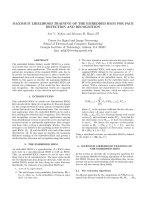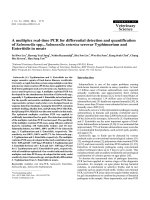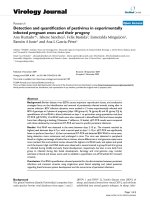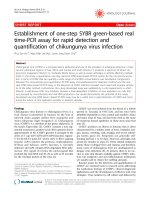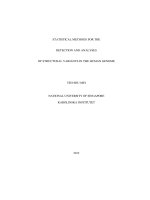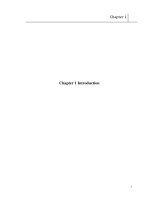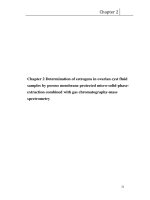Detection and quantification of trace airborne transfluthrin concentrations via air sampling and thermal desorption gas chromatography-mass spectrometry
Bạn đang xem bản rút gọn của tài liệu. Xem và tải ngay bản đầy đủ của tài liệu tại đây (527.91 KB, 5 trang )
Journal of Chromatography A, 1573 (2018) 156–160
Contents lists available at ScienceDirect
Journal of Chromatography A
journal homepage: www.elsevier.com/locate/chroma
Short communication
Detection and quantification of trace airborne transfluthrin
concentrations via air sampling and thermal desorption gas
chromatography-mass spectrometry
Michael W.C. Kwan a , Jason P. Weisenseel b , Nicholas Giel a , Alexander Bosak a ,
Christopher D. Batich c,d , Bradley J. Willenberg a,∗
a
University of Central Florida College of Medicine, Department of Internal Medicine, 6900 Lake Nona Blvd, Orlando, FL, 32827, USA
PerkinElmer Inc., 940 Winter St, Waltham, MA, 02451, USA
c
University of Florida, College of Engineering, Departments of Materials Science and Engineering, 549 Gale Lemerand Dr, Gainesville, FL, 32611, USA
d
University of Florida, J. Crayton Pruitt Family Biomedical Engineering, 1275 Center Dr, Biomedical Sciences Building, JG-56, Gainesville, FL, 32611, USA
b
a r t i c l e
i n f o
Article history:
Received 2 July 2018
Received in revised form 29 August 2018
Accepted 31 August 2018
Available online 5 September 2018
Keywords:
Thermal desorption
GC–MS
Transfluthrin
Pyrethroids
Active air sampling
Passive release
a b s t r a c t
A rapid thermal desorption-gas chromatography-electron ionization-mass spectrometry (TD-GC-EI-MS)
method for airborne transfluthrin detection is studied. Active air sampling of 9 L over 1 h at 23 ◦ C through a
Tenax® -loaded tube resulted in efficient capture of airborne transfluthrin. Subsequent thermal desorption
was employed to achieve an LOD of 2.6 ppqv (parts per quadrillion by volume). A minimum primary
desorption temperature of 300 ◦ C is necessary for optimal recovery of sample from the Tenax® adsorbent.
The matrix effects of indoor air lead to an error of 10.9% and 10.5% recovery of sample (10 pg and 100 pg
loaded tubes, respectively). The linear range was 74–74,000 ppqv with a correlation coefficient of 0.9981.
Active air sampling of a novel passive release device revealed a ∼150 pg/L airborne concentration gradient
over 1 m, providing spatial characterization of the device’s performance. This efficient method allows for
the remote collection of samples and rapid analysis of airborne transfluthrin from industrial applications,
optimization studies of commercial products as well as domestic/household monitoring.
© 2018 The Author(s). Published by Elsevier B.V. This is an open access article under the CC BY license
( />
1. Introduction
Transfluthrin ((1R,3S)-3-(2,2-Dichlorovinyl)-2,2-dimethyl-1cyclopropanecarboxylic acid (2,3,5,6-tetrafluorophenyl)methyl
ester) is a semi-volatile organic compound of the pyrethroid class
of insecticides that is routinely used as an indoor insecticide.
Transfluthrin (TF) works as a potent dipteran sodium channel
agonist and can elicit effects such as repellency, restlessness,
knockdown and death in mosquitoes [1]. Commercial use of TF
along with the inevitable exposure to humans has generated
interest in quantifying low levels of airborne TF with the ultimate
goal of understanding what constitutes an effective airborne
concentration against mosquitoes without placing undue harm
on people [2–4]. Previously, our group has developed a passive
release device that releases airborne TF at a constant rate into
the air over several hundred hours [5, unpublished data]. The
precise quantification of airborne TF emanating from the device
∗ Corresponding author.
E-mail address: (B.J. Willenberg).
will provide insight into device performance and may help guide
optimization. Furthermore, the lower limit of efficacy for each
of TF’s effects towards mosquitoes (i.e. confusion, excitation,
knockdown and death) are currently unknown with a previous
study suggesting that TF can effectively knockdown mosquitos at
one parts per trillion by volume (1 pptv ) [6]. Proper dissemination
of TF is paramount as over and underexposure of insecticides have
been linked to spurring resistance development [7–10].
Gas chromatography-electron ionization-mass spectrometry
(GC-EI-MS) is a powerful tool in separating, analyzing and quantifying the constituents of a complex mixture of volatiles. Previous
methods for monitoring TF airborne concentrations via GC-EIMS include air sampling followed by ultrasound-assisted solvent
extraction [2], solid-phase microextraction [11] and direct air measurements using Proton-Transfer-Reaction Mass Spectrometry [4].
These methods have reported airborne concentrations in the range
of g/m3 , pg/gram and single-digit ng/m3 , respectively.
The shift towards the reduction in extraction mass (aka microextractions), be it liquid or solid phase extraction, is attractive as the
analyte can be concentrated from the adsorbent into microliters of
solvent that can be injected into the column. However, the handling
/>0021-9673/© 2018 The Author(s). Published by Elsevier B.V. This is an open access article under the CC BY license ( />
M.W.C. Kwan et al. / J. Chromatogr. A 1573 (2018) 156–160
of micro-volumes can be cumbersome and sample loss is known to
occur. In this regard, thermal desorption (TD) is advantageous over
microextractions as the lack of extraction matrix results in higher
recovery of the sample, reduced potential contamination, and more
rapid analysis [12]. Additionally, this study used an automated TD
system which helped to reduce human error. Although previous
works have utilized this method, no detailed methodology for the
quantification of TF via TD-GC-EI-MS has been, to our knowledge,
reported [6,13]. Furthermore, the International Organization for
Standardization (ISO) standard on indoor air sampling of volatile
organic compounds (VOCs) with TD-GC-EI-MS (ISO 16000-6:2011)
is broad in scope as the chemical and physical characteristics of
VOCs encompass a wide range. To this end, we report the quantification of indoor airborne TF via TD-GC-EI-MS and detail the
instrumental and experimental conditions needed to obtain similar
results. This method was then used to characterize the emanations
of a novel passive release device.
2. Materials and methods
2.1. Instrumentation and materials
®
TD-GC-EI-MS was accomplished using a Perkin Elmer Clarus
®
SQ 8C mass spectrometer, Clarus 580 gas chromatograph and
TM
TurboMatrix 650 automated thermal desorber (Waltham, MA,
TM
TC 220 conditioning oven
USA). A Perkin Elmer TurboMatrix
(Waltham, MA, USA) was used to condition thermal desorption
tubes. An SKC, Inc. AirChek air sampler pump Model 224-44XR
(Eighty Four, PA, USA) was used to collect air samples onto
Markes International, Inc. thermal desorption tubes (Sacramento,
®
CA, USA) filled with the adsorbent Tenax 35/60. A MesaLabs Bios
Defender 510 air flow calibrator was used to calibrate the SKC, Inc.
quad adjustable low flow holder (SKC, Inc., Eighty Four, PA, USA).
TM
Chromasolv methanol (HPLC Grade) was purchased from Fisher
Scientific, Inc. (Hampton, NH, USA). Ultra-high purity helium was
provided by Airgas, Inc. (Radnor, PA, USA) and nitrogen was generated in-house by a Parker Balston Model N2-35 nitrogen generator
(Parker Hannifin Corporation, Lancaster, NY).
2.2. Standard preparation
Standards of TF were prepared using Bayer TF obtained from
United States Department of Agriculture-Agricultural Research
Service-Center for Medical, Agricultural and Veterinary Entomology (USDA-ARS-CMAVE, Gainesville, FL Daniel L. Kline, see
157
acknowledgements). A stock solution of 10 mg/mL of TF in isopropanol was prepared volumetrically and serial dilutions with
isopropanol were used to prepare a set of 4–8 working standards
ranging from 10 pg/L to 10 ng/L. Standard tubes were spiked at
the inlet with 0.5 L of liquid working standard and transferred
®
onto the Tenax bed with a flow of N2 at 100 mL/min for 15 min.
All thermal desorption tubes were conditioned with N2 at a rate
of 100 mL/min prior to spiking with working standards. The conditioning cycle was 250 ◦ C for 20 min, followed by 300 ◦ C for 20 min
and then 335 ◦ C for 30 min. The heating rate for all ramp periods
was 10 ◦ C/min.
2.3. Parameters for quantitative analysis
To recover the TF from the sample tubes, a two-stage thermal desorption method was used. The primary desorption from
the sample tube was performed at various temperatures ranging
from 200 to 335 ◦ C for three minutes to assess the optimum desorption temperature. Prior to secondary desorption, the samples
®
were collected on a Tenax concentrating trap held at -20 ◦ C via a
flow of high purity helium at a rate of 75 mL/min. The heated valve
in the thermal desorption instrument was maintained at 300 ◦ C and
transfer line to the GC was maintained at 280 ◦ C at all times to prevent condensation of the analytes in either the valve or transfer line.
To deliver the sample to the GC column for analysis, secondary desorption of the sample from the concentrating trap was performed
by heating the trap to 335 ◦ C at a rate of 40 ◦ C/sec with a helium
flow rate of 2 mL/min.
The temperature program for the GC was two minutes at 55 ◦ C
followed by a 20 ◦ C/min ramp to 290 ◦ C and then a hold at 290 ◦ C for
4.25 min. Helium was used as the carrier gas and the flow rate was
2 mL/min. The column utilized was a Perkin Elmer Elite 624 (Cat.
No. N9315068) mid polar column (6% cyanopropyl phenyl – 94%
dimethyl polysiloxane) with dimensions 30 m length, 0.25 mm ID
and 1.4 m film thickness. The transfer line from the GC column to
the MS source was maintained at 250 ◦ C and the electron ionization
(EI) source was maintained at 280 ◦ C.
The mass spectrum of TF was identified (positive ion mode
– 70 eV) for TF by identifying the target ion at m/z 163 and its
fragmentation qualifying peak at m/z 91 (Fig. 1), which is consistent with previously observed mass spectra of TF [14–19]. For
quantitative analysis, the mass spectrometer was set to selected
ion recording (SIR) mode at 163 m/z with the resulting SIR chromatograph integrated and the peak area of the TF peak used for
quantification.
Fig. 1. Mass spectrum of transfluthrin via EI at 70 eV with target ion 163 m/z and the qualifier 91 m/z. The chemical structure of transfluthrin and the hypothesized 163 m/z
fragment is shown above. Background subtraction of the column was applied.
158
M.W.C. Kwan et al. / J. Chromatogr. A 1573 (2018) 156–160
2.4. Statistical determination of limit of detection (LOD) and limit
of quantification (LOQ)
The LOD and LOQ were determined experimentally by signal to
noise ratio (SNR) as well as the standard error of estimates (SEE)
approach. For the SNR measurement, the LOD must have an SNR of
at least three while the LOQ was determined at the SNR of 10 [20].
The calculation for the LOD following the SEE approach is shown
in Eq. (1) where sy/x is the standard error of the estimate, m is the
slope of the fitted regression line and k-factor is 3.3 and 10 for the
LOD and LOQ as noted by previous authors [21,22].
LOD = k · sy/x /m
(1)
Eq. (2) shows the calculation for the standard error of estimates where yi is the sample data and yF is the value of the fitted
regression line from matrix spiked samples that corresponds to the
concentration of TF used to achieve value yi . Concentrations near
the low end of the linear range was used for SEE calculations.
sy/x =
(yi − yF )2
(2)
Due to the large background drift (column bleed), the European Pharmacopoiea chromatographic method of selecting a large
background region to sample the noise is not achievable without
potentially misleading baseline correction techniques [20]. Thus,
the background noise was taken 0.1 min away from the analyte
peak in each direction. Data was compiled from three different
experiments over different days with samples collected in triplicate.
2.5. Air sampling
Air sampling of airborne TF was accomplished using a novel passive release device created with the same TF source used to create
the standards in Section 2.2. This device was composed of a cotton wick with an interior reservoir of isopropanol and TF using the
same Bayer TF from Section 2.2 [5]. The device was activated and
subsequently allowed to release volatiles in the center of a room of
5.2 × 3 × 2.7 m. The air sampling occurred within 3 cm of the device,
referred to here as the point of generation (POG), as well as one
meter from the device at the same height (1 m) above the floor.
Both the air supply (∼0.17 m3 /s) and exhaust (∼0.21 m3 /s) were
continuously running and located on the ceiling of the room.
Thermal desorption tubes were placed onto adjustable low flow
holder suspended one meter off the ground at both POG and one
meter. Flow rate for each flow port was adjusted to 150 mL/min
and validated using the air flow calibrator. Air sampling without a
passive release device present was accomplished to establish the
background signal. Afterwards, a device was activated and placed in
the room and allowed to emanate for 60 min after which air samples
®
were collected on Tenax 35/60 providing an average of 9 L of sample volume passing through each tube. Brass caps equipped with
polytetrafluoroethylene ferrules were secured onto these air sample tubes to protect the sample from contamination and potential
sample loss between collection and analysis.
Airborne concentration of TF was recorded in parts per
quadrillion by volume (ppqv ) using the following equation:
ppqv = 1015 · molTF · 24.6 /V
(3)
Where ppqv is the parts per quadrillion by volume of TF, molTF is the
moles of TF quantified by TD-GC-EI-MS, 24.6 is the ratio of liters to
moles according to the ideal gas law at 23 ◦ C and 101,325 Pa and V
is the average volume (9 L) of air sampled in liters.
The matrix effect of indoor air on the recovery of TF was studied
by exposing TF-spiked tubes to indoor air at 150 mL/min for one (1)
hour or the nitrogen generator for one (1) hour at 100 mL/min.
Fig. 2. Effect of primary desorption temperature on transfluthrin recovery from
spiked tubes. At temperatures below 300 ◦ C, there is carryover transfluthrin remaining on the tube. Samples were normalized to the highest intensity within each
experimental repeat. Error bars represent sample standard deviation.
3. Results and discussion
3.1. Optimization of parameters and methods
To assess the retention of TF on the column, blank tubes were
analyzed between each spiked tube. The measured instrumental
transfluthrin carry over was typically less than 1% of the signal
intensity of the spiked sample TF. The small mass of TF on the
column (<10 ng) allowed the use of a splitless transfer from the
secondary desorption. The retention time of TF was 12.94 min.
Primary desorption temperatures were varied to elucidate the
optimal temperature for recovery of TF from the sample tube. The
results indicate that a 200 ◦ C desorption temperature only recovers 70.5% of potential TF and that a desorption temperature above
300 ◦ C is needed for maximum recovery (Fig. 2). The signal intensity was normalized to the largest signal obtained, typically from
the 325 ◦ treated tubes. The recovery approaches a maximum at
300 ◦ C with an average recovery of 92.9%. Sample tubes were analyzed twice to check for any TF carry over and no signal was detected
on the second run when higher (+300 ◦ C) desorption temperatures
were used on the first run. This experiment was repeated three
times with samples collected in triplicate.
3.2. Performance of method/figures of merit lower detection limit,
lower quantification limit, accuracy and precision
®
The total ion chromatograms (TIC) of unspiked Tenax tubes
did not yield any meaningful noise at the retention time of TF due
to the background from the column bleed convoluting any noise
measurements. Therefore, no accurate standard deviation of blank
tubes could be ascertained for statistical LOD or LOQ determination
without applying any potentially misleading baseline corrections.
For example, a baseline correction method utilizing Gram-Schmidt
(GS) orthogonalization was adapted from a GC-IR study [23] but the
resulting chromatogram was riddled with artificial peaks (data not
shown). To avoid using baseline correction, a modified statistical
approach based on the SEE was employed as described in Section
2.4 [22].
Analyte peak area was used for quantitation since using peak
height generally had a larger variance. Thus, root mean squared
(RMS) SNR was used to determine the LOD and LOQ and defined as
the TF quantity that yields a peak area of 3 and 10 times larger than
the noise [24]. Both empirical (RMS SNR) and statistical (SEE) values
were obtained and reported here as they provide complimentary
information on the detection limit of this method. The empirical
method gives insight into the detection of a very low signal that is
distinct from a blank background and helps take into account the
instrumental noise; it is more akin to an instrumental detection
limit. The SEE provides insight into the statistical variation of the
M.W.C. Kwan et al. / J. Chromatogr. A 1573 (2018) 156–160
159
Table 1
Overview of TD-GC–MS method performance including LOD and LOQ.
Compound
SIM (Target, Qualifier)
LOD via SEE
(pg, ppqv )
LOQ via SEE
(pg, ppqv )
LOD via SNR
(pg, ppqv )
LOQ via SNR
(pg, ppqv )
Linear Range
(pg, ppqv )
R2, a
Transfluthrin
163, 91
7.6 ± 6.9, 56 ± 50.8
23 ± 21, 170 ± 150
2.2 ± 1.5, 16 ± 11
10.3 ± 2.8, 76 ± 21
10–10000, 74–74000
0.9919
a
Taken from LOD/LOQ experimental data.
methodology (i.e. human error, sample preparation, matrix effects,
etc.) and may be compared to the method detection limit.
The LOD and LOQ obtained from the SNR method were 2.16 pg
(16 ppqv ) and 10.3 pg (76 ppqv ) respectively. The SEE at the lowest
linear concentration yielded an LOD and LOQ of 7.60 pg (56 ppqv )
and 23.0 pg (170 ppqv ) respectively. Since the spiked TF standards
were not generated using active air sampling, the corresponding
ppqv values above were calculated using Eq. 3 based on a 9 L volume
to facilitate comparison with the air sampling experiment. These
figures of merit were obtained from averaging four experimental
repeats with samples collected in triplicate and are summarized
in Table 1. Previous work on TD-GC-EI-MS determination of airborne TF reported a detection limit of 2000 pg/tube while here we
report that 10.28 pg/tube can be quantified [13]. When compared
to ultrasound-assisted solvent extraction of actively sampled air,
the LODs reported here were as much as five times less than that
of the previous authors’ LOD when using similar LOD calculations,
demonstrating a significant improvement in sensitivity [2].
The instrument used here had a linear range of four orders of
magnitude when measuring TF. At high concentrations (20 ng per
tube) the response became nonlinear due to detector saturation.
Therefore, the linear range used in this study was from 10 pg–10 ng
TF on tube. Regression was performed over this concentration range
using at least 3 spiked standards with a normalized slope of 0.9661,
intercept of 0.0005, standard error of 0.01996 and R2 value of
0.9981. The y-intercept was not forced to zero because the putative
criteria for doing so involves a standard deviation measurement of
the blank which was not compatible with this method.
The use of negative chemical ionization (NCI) may further
improve the detection of TF in GC-EI-MS [25]. A previous study
of TF using liquid-liquid extraction GC-EI-MS reported an LOQ of
1 ng/mL [26]. This improvement is attributed to the large molecular ion formed in NCI; this larger ion has less interference when
compared to the smaller fragments obtained from EI [25]. Electron capture detection (ECD) has also been shown previously to
improve detection of pyrethroids when compared to GC-EI-MS [2]
and tandem mass spectrometry such as collision-induced dissociation (CID-MS/MS) may provide yet another approach to further
increase the sensitivity/detection performance.
3.3. Air sampling of TF
To test the method with a relevant matrix, air was sampled in
the vicinity of a passive release device [5]. This device passively
releases TF dissolved in isopropanol via a wick and reservoir design
[5]. Sampling near the device and one meter away revealed a gradient in release with ∼200 pg/L (13.1 ppb) being adsorbed near the
device and ∼50 pg/L (3.44 ppb) at one meter (Fig. 3). Air sampling
without a device present revealed low background signal ∼15 pg/L
(∼1 ppb). Air sampling data were recorded over three experiments
and samples were replicated 4–8 times. One outlier was rejected
from the data set using a Dixon’s Q-test with a confidence interval
of 99%. The source of anomalous behavior is suspected to be a TF
contaminated cap. During the analysis, no signal was observed in
®
the secondary breakthrough tubes suggesting that Tenax 35/60
effectively captures all the TF. Finally, the effect of indoor air had
a 10% effect on recovery when comparing spiked samples condi-
Fig. 3. Airborne concentration of transfluthrin measured by active air sampling
and TD-GC–MS with a passive transfluthrin releasing device (Device) and without
a device (Control). Two locations were studied including the point-of-generation
(POG) and one meter (1 m) from the device. These locations were kept the same
when no device was studied. An unweighted linear regression was used for calibration and data was collected as three experimental repeats and 4–8 replicates. Error
bars represent the sample standard deviation.
Table 2
Recovery performance of TD-GC–MS with RSD of spiked standards and the effects
of Indoor air as a matrix.
Spike (pg)
RSD with Standards (%)
Matrix Effect on Recovery (%)
10
100
13.0 ± 10.1
6.30 ± 1.25
10.90 ± 9.41
10.5 ± 5.83
tioned with indoor air or nitrogen at two concentrations near the
lower end of the linear region (Table 2).
4. Conclusion
Here we describe a method to quantify airborne concentrations
of TF using TD-GC-EI-MS with active air sampling. A two-stage
desorption via a cryotrap was employed to eliminate a typical
microextraction step thus improving the recovery of collected sample. The use of a splitless injection ensures that all the sample will
reach the detector thereby increasing the accuracy of the method.
Finally, active air sampling can be used to collect and analyze large
volumes of air for exceedingly trace amounts of compound – effectively increasing the detectability of the method.
The column bleed from the high temperature GC method was
not circumvented with a Gram-Schmidt baseline correction. Future
studies exploring high temperature columns or a singular value
decomposition (SVD) method [27] to eliminate the column bleed
background may further improve this method.
The ISO for active air sampling of VOCs using TD-GC–MS suggests a range of temperatures, flow rates and times to successfully
desorp the analyte (ISO 16000-6:2011(E)). Here we report high performance TD with values for several parameters that lie outside the
typical range in the ISO. The use of a more aggressive desorption
method was needed to achieve a >90% recovery of spiked samples.
160
M.W.C. Kwan et al. / J. Chromatogr. A 1573 (2018) 156–160
At different airborne concentrations of TF, the insecticide displays unique effects; at extremely low airborne concentrations TF
has been shown to be an attractant to mosquitos while increasing
concentrations eventually leads to death [1]. Currently, the concentrations at which these unique behaviors arise are not known but
a previous study has suggested that a concentration of 1 pptv may
be enough to repel mosquitos [6]. With the LOD and LOQ reported
in this method, the airborne concentrations on the order of single
digit pptv can be quantified. This level of detection makes it possible to study the various behavioral effects of low concentrations
of TF on mosquito behavior. The method was tested by measuring
the airborne concentration of TF emanating from a novel passive
release device, demonstrating that low levels of airborne TF can
reliably be quantified.
Disclaimer
Any opinions, findings, and conclusions or recommendations
expressed in this material are those of the author(s) and do not
necessarily reflect the position or policy of the Government and no
official endorsement should be inferred.
Conflict of interest statement
BJW has minor ownership interests in Sustained Release Technologies, Inc. and Pest Natural, Inc. («5%); these entities did not
contribute to the support of this study.
Acknowledgements
This project was sponsored in part by the Department of
the Army, U.S. Army Contracting Command, Aberdeen Proving
Ground, Natick Contracting Division, Ft Detrick MD via a grant
to CDB from the Armed Forces Pest Management Board (AFPMB)
Deployed Warfighter Protection Research Program (DWFP- Grant
No.: W911QY-15-1-0003) and by UCF Preeminent Postdoctoral
(P3) Program award to MWCK. The authors would also like to
thank Jedidiah Kline (University of Florida) for assistance in creating the novel passive release devices. Transfluthrin (TF) utilized in
this project was supplied to USDA-ARS-CMAVE (Gainesville, FL) by
Bayer through a Material Transfer and Research Agreement (MTRa).
The MTRa allows transfer of TF to a third party participating in
research associated with DWFP.
References
[1] T.G.E. Davies, L.M. Fields, P.N.R. Usherwood, M.S. Williamson, DDT, pyrethrins,
pyrethroids and insect sodium channels, IUBMB Life 59 (2007) 151–162,
/>[2] R. Barro, C. Garcia-Jares, M. Llompart, M.H. Bollain, R. Cela, Rapid and sensitive
determination of pyrethroids indoors using active sampling followed by
ultrasound-assisted solvent extraction and gas chromatography, J.
Chromatogr. A 1111 (2006) 1–10, />01.093.
[3] A. Vesin, P. Glorennec, B.L. Bot, H. Wortham, N. Bonvallot, E. Quivet,
Transfluthrin indoor air concentration and inhalation exposure during
application of electric vaporizers, Env. Int. 60 (2013) 1–6, />1016/j.envint.2013.07.011.
[4] A. Vesin, E. Quivet, B. Temime-Roussel, H. Wortham, Indoor transfluthrin
concentration levels during and after the application of electric vaporizers
using a Proton-Transfer-Reaction Mass Spectrometer, Atmos. Environ. 65
(2013) 123–128, />[5] B.J. Willenberg, P.G. Koehler, C. Batich, G. Georgiades, Methods and Devices
for Sustained Release of Substances. USA 9,258,988, 2015, January 22.
[6] L.M. Meyers, Mosquito Mortality and the Characterization of Airborne
Transfluthrin Concentrations in a Semi-Field Setting, Uniformed Services
University, School of Medicine, Bethesda, MD, USA, 2015.
[7] S.L. Bates, J.Z. Zhao, R.T. Roush, A.M. Shelton, Insect resistance management in
GM crops: past, present and future, Nat. Biotechnol. 23 (2005) 57–63, http://
dx.doi.org/10.1038/nbt1056.
[8] V. Corbel, F. Chandre, C. Brengues, M. Akogbeto, F. Lardeux, J.M. Hougard, P.
Guillet, Dosage-dependent effects of permethrin-treated nets on the behavior
of Anopheles Gambiae and the selection of pyrethroid resistance, Malar. J. 3
(2004) 22–31, />[9] C.F. Curtis, J.E. Miller, M.H. Hodjati, J.H. Kolaczinski, I. Kasumba, Can anything
be done to maintain the effectiveness of pyrethroid-impregnated bednets
against malaria vectors? R. Soc. 353 (1998) 1769–1775, />1098/rstb.1998.0329.
[10] W. Kang, B. Gao, H. Jiang, H. Wang, T. Yu, P. Yu, B. Xu, C.F. Curtis, Tests for
possible effects of selection by domestic pyrethroid resistance in culicine and
anopheline mosquitos in Sichuan and Hubei, China, Ann. Trop. Med. Parasitol.
89 (1995) 677–684, />[11] M. Fernandez-Alvarez, M. Llompart, J.P. Lamas, M. Lores, C. Garcia-Jares, R.
Cela, T. Dagnac, Simultaneous determination of traces of pyrethroids,
organochlorines and other main plant protection agents in agricultural soils
by headspace solid-phase microextraction-gas chromatography, J.
Chromatogr. A 1188 (2008) 154–163, />2008.02.080.
[12] K. Demeestere, J. Dewulf, K.D. Roo, P.D. Wispelaere, H.V. Langenhove, Quality
control in quantification of volatile organic compounds analysed by thermal
desorption-gas chromatography-mass spectrometry, J. Chromatogr. A 1186
(2008) 348–357, />[13] S.B. Ogoma, A.S. Mmando, J.K. Swai, S. Horstmann, D. Malone, G.F. Killeen, A
low technology emanator treated with the volatile pyrethroid transfluthrin
confers long term protection against outdoor biting vectors of lymphatic
filariasis, arboviruses and malaria, PLoS Negl. Trop. Dis. 11 (2017) 1–22,
/>[14] Y.J. Lian, G.F. Pang, H.R. Shu, C.L. Fan, Y.M. Liu, J. Feng, Y.P. Wu, Q.Y. Chang,
Simultaneous Determination of 346 Multiresidue Pesticides in Grapes by
PSA-MPD and GC-MS-SIM, J. Agric. Food Chem. 58 (2010) 9428–9453, http://
dx.doi.org/10.1021/jf1019592.
[15] N. Posecion, E. Ostrea, D. Bielawski, M. Corrion, J. Seagraves, Y. Jin, Detection
of exposure to environmental pesticides during pregnancy by the analysis of
maternal hair using GC–MS, Chromatographia 64 (2006) 681–687, http://dx.
doi.org/10.1365/s10337-006-0092-7.
[16] T. Yoshida, Identification of urinary metabolites in rats administered the
fluorine-containing pyrethroids metofluthrin, profluthrin, and transfluthrin,
Toxicol. Environ. Chem. 94 (2012) 1789–1804, />02772248.2012.729838.
[17] N. Posecion, E. Ostrea, D. Bielawski, M. Corrion, J. Seagraves, Y. Jin, Detection
of exposure to environmental pesticides during pregnancy by the analysis of
maternal hair using GC–MS, Chromatographia 64 (2006) 681–687, http://dx.
doi.org/10.1365/s10337-006-0092-70009-5893/06/12.
[18] A. Vesin, G. Bouchoux, E. Quivet, B. Temime-Roussel, H. Wortham, Use of the
HS-PTR-MS for online measurements of pyrethroids during indoor insecticide
treatments, Anal. Bioanal. Chem. 403 (2012) 1907–1921, />1007/s00216-012-6003-x.
[19] M. Fernandez-Alvarez, M. Lores, M. Llompart, C. Garcia-Jares, R. Cela, The
photochemical behavior of five household pyrethroid insecticides and a
synergist as studied by photo-solid-phase microextraction, Anal. Bioanal.
Chem. 388 (2007) 1225–1247, />[20] A. Shrivastava, V.B. Gupta, Methods for the determination of limit of detection
and limit of quantification of the analytical methods, Chron. Young Sci. 2
(2011) 21–25, />[21] D.A. Armbruster, M.D. Tillman, L.M. Hubbs, Limit of Detection (LOD)/Limit of
Quantification (LOQ): comparison of the empirical and the statistical methods
exemplified with GC–MS assays of abused drugs, Clin. Chem. 40 (1994)
1233–1238, PMID: 8013092.
[22] E. Desimoni, B. Brunetti, About estimating the limit of detection by the signal
to noise approach, Pharm. Anal. Acta 6 (2015) 1–4, />2153-2435.1000355.
[23] J.A. Haseth, T.L. Isenhour, Reconstruction of gas chromatograms from
interferometric gas chromatography/infrared spectrometry data, Anal. Chem.
49 (1977) 1977–1981, />[24] J. Vial, A. Jardy, Experimental Comparison of the Different Approaches To
Estimate LOD and LOQ of an HPLC Method, Anal. Chem. 71 (1999) 2672–2677,
/>[25] M.L. Feo, E. Eljarrat, D. Barcelo, Determination of pyrethroid insecticide in
environmental samples, Trends Analyt. Chem. 29 (2010) 692–705, http://dx.
doi.org/10.1016/j.trac.2010.03.011.
[26] S. Hooshfar, T.B. Mortuza, C.A. Rogers, M.R. Linzey, D.R. Gullick, J.V. Bruckner,
C.A. White, M.G. Bartlett, Gas Chromatography/negative chemical ionization
mass spectrometry of transfluthrin in rat plasma and brain, Rapid Commun.
Mass Spectrosc. 31 (2017) 1573–1581, />[27] Z. Xu, X. Sun, P.B. Harrington, Baseline correction method using an orthogonal
basis for gas chromatography/mass spectrometry data, Anal. Chem. 83 (2011)
7464–7471, />

